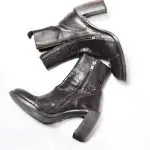Like a shield against summer’s relentless heat, moisture-wicking clothing promises relief from uncomfortable skin irritation and heat rash. You might wonder if these fabrics truly live up to the hype or if they’re just another trend. Understanding how they manage sweat and interact with your skin could change the way you choose your workout gear or summer wardrobe. But what exactly makes moisture-wicking fabrics different from regular clothing?
Table of Contents
Key Takeaways
- Moisture-wicking fabrics pull sweat away from skin, speeding evaporation and reducing heat rash risk.
- These fabrics keep skin dry and cool by balancing breathability and moisture control effectively.
- Synthetic fibers like polyester wick moisture better than cotton, lowering prolonged skin dampness and irritation.
- Moisture-wicking clothing reduces friction and skin irritation by maintaining a breathable, dry barrier.
- Scientific studies confirm moisture-wicking materials prevent heat rash better than traditional moisture-trapping fabrics.
Understanding Moisture-Wicking Fabrics and Their Function
Although moisture-wicking fabrics might seem like just another clothing trend, they play an essential role in managing sweat and keeping your skin dry.
You’ll notice these fabrics use advanced fabric technology designed specifically to enhance moisture absorption and move sweat away from your skin. Unlike traditional cotton, moisture-wicking materials don’t trap moisture; instead, they pull it to the fabric’s surface, where it evaporates quickly.
Advanced fabric technology pulls sweat from your skin to the surface, where it evaporates quickly, unlike traditional cotton.
This process helps you stay comfortable and dry, especially during physical activities or hot weather. When you wear moisture-wicking clothing, you’re relying on smart fabric technology that balances breathability and moisture control, making it much more effective at managing sweat than regular fabrics.
This understanding is key before exploring how these fabrics affect skin health.
How Moisture-Wicking Clothing Helps Reduce Heat Rash
When you wear moisture-wicking clothing, it pulls sweat away from your skin, helping it evaporate quickly.
This keeps your skin dry and reduces the chances of irritation that lead to heat rash.
Sweat Evaporation Efficiency
Because moisture-wicking clothing pulls sweat away from your skin, it speeds up evaporation and keeps you dry.
These fabrics excel in sweat absorption, quickly drawing moisture from your body to the outer layers of the garment. This transfer boosts evaporation rates by exposing sweat to air, allowing it to evaporate faster than it would on your skin.
When sweat evaporates efficiently, your body cools down more effectively, reducing the risk of heat rash caused by trapped moisture.
By enhancing sweat evaporation, moisture-wicking clothing prevents prolonged skin wetness, which often leads to irritation.
Skin Dryness Maintenance
If you want to prevent heat rash, keeping your skin dry is essential, and moisture-wicking clothing plays a key role in this.
By efficiently pulling sweat away, these fabrics help maintain skin dryness, supporting your skin hydration strategies and preventing flakiness.
Here’s how moisture-wicking clothing helps reduce heat rash:
- Draws moisture from your skin to the fabric’s surface, speeding evaporation.
- Reduces prolonged dampness that can irritate and inflame your skin.
- Maintains a breathable barrier, keeping skin cool and dry throughout activity.
Scientific Evidence Supporting Moisture-Wicking Materials
Although many fabrics claim to reduce heat rash, moisture-wicking materials have proven their effectiveness through numerous scientific studies.
These studies show that advanced fabric technology enhances moisture control by pulling sweat away from your skin to the fabric’s surface, where it evaporates quickly. This process keeps your skin drier and cooler, reducing the friction and irritation that cause heat rash.
When you wear moisture-wicking clothing, you’re actively supporting your body’s natural cooling system, which helps maintain skin health in hot or humid conditions.
Scientific evidence confirms that choosing these fabrics can considerably lower the risk of heat rash and discomfort compared to traditional materials that trap moisture.
Comparing Synthetic and Natural Fibers for Skin Health
When choosing between synthetic and natural fibers, you’ll notice they handle moisture very differently.
Synthetic fabrics are designed to wick sweat away quickly, while natural fibers often feel softer but might hold onto moisture longer.
Understanding these differences can help you pick clothing that keeps your skin comfortable and less prone to heat rash.
Moisture Management Differences
Choosing the right fabric plays an essential role in managing moisture and preventing heat rash. Different materials handle moisture retention and fabric breathability in unique ways, impacting your skin health. Here’s what to take into account:
- Synthetic fibers often excel at wicking moisture away from your skin, keeping you dry but sometimes trapping odors.
- Natural fibers like cotton absorb moisture but may retain it longer, increasing the risk of irritation if the fabric stays damp against your skin.
- Blended fabrics aim to balance moisture management and breathability, reducing moisture buildup without sacrificing comfort.
Comfort and Breathability
Understanding how different fabrics feel against your skin can make a big difference in comfort, especially in hot conditions.
Natural fibers like cotton offer a soft fabric texture that feels gentle and breathable, promoting better air circulation. This helps keep your skin cool and reduces irritation risk.
On the other hand, synthetic fibers are designed to wick moisture away quickly but sometimes feel less soft and can trap heat if the fabric doesn’t allow enough air circulation.
When choosing moisture-wicking clothing, consider how the fabric texture interacts with your skin and whether it enhances breathability.
Prioritizing comfort and airflow helps prevent heat rash and skin irritation, keeping you cooler and more comfortable throughout the day.
Specialized Moisture-Wicking Fabrics in Medical Use
Although many fabrics claim to manage moisture, specialized moisture-wicking materials used in medical settings go beyond basic comfort—they actively help prevent heat rash and skin irritation.
These fabrics use advanced fabric technology designed specifically for medical applications where skin health is critical.
When you wear these specialized materials, you benefit from:
- Enhanced moisture transfer that keeps your skin dry, reducing friction and irritation.
- Antimicrobial properties that limit bacterial growth, preventing infections linked to sweat buildup.
- Lightweight, breathable construction that maintains airflow, helping regulate your body temperature effectively.
Practical Tips for Choosing and Using Moisture-Wicking Apparel
When you pick moisture-wicking apparel, focusing on fabric quality and fit can make all the difference in comfort and effectiveness.
Prioritize synthetic blends like polyester or nylon that excel at pulling moisture away from your skin. Avoid cotton, as it traps sweat and can worsen heat rash. Pay close attention to fabric selection to guarantee breathability and quick drying.
Choose garments with a snug but not tight fit to allow proper airflow without causing chafing. Incorporate smart layering strategies by wearing a lightweight moisture-wicking base layer under looser clothing to enhance ventilation and moisture management.
Remember to wash your gear regularly to maintain fabric performance. By selecting the right materials and layering thoughtfully, you can minimize skin irritation and stay comfortable in hot conditions.
Frequently Asked Questions
Can Moisture-Wicking Clothing Be Worn Every Day Without Causing Skin Dryness?
You can wear moisture-wicking clothing for daily wear without causing skin dryness, but you shouldn’t rely on it alone. Make sure you maintain proper skin hydration by moisturizing regularly to keep your skin balanced and healthy.
Are Moisture-Wicking Fabrics Safe for People With Sensitive Skin Allergies?
If you have fabric sensitivity or allergies, you should check moisture-wicking fabrics carefully. They’re usually safe, but it’s smart to do allergy testing first to avoid irritation and guarantee comfort for your sensitive skin.
How Often Should Moisture-Wicking Clothes Be Washed to Maintain Effectiveness?
You should follow proper laundry frequency to keep moisture-wicking fabrics effective. Wash them after each use using gentle fabric care methods—avoid fabric softeners and high heat—to maintain their moisture-wicking properties and prolong their lifespan.
Do Moisture-Wicking Clothes Protect Against Sunburn or UV Exposure?
You might think moisture-wicking clothes block UV rays, but they don’t guarantee UV protection. For true sun safety, you’ll need garments labeled with UPF ratings or apply sunscreen alongside moisture-wicking fabrics.
Can Moisture-Wicking Clothing Be Combined With Other Treatments for Heat Rash?
You can combine moisture-wicking clothing with other treatments like topical creams in combination therapies. Choosing the right fabric types enhances comfort and effectiveness, helping you better manage heat rash and reduce skin irritation.
- What Is Cotton Velvet? Characteristics, Benefits & Common Uses - June 22, 2025
- Fabrics Similar to Velvet: Alternatives & Look-Alike Textiles - June 22, 2025
- Velvet Fabric Sustainability: Environmental Impact & Eco-Friendly Options - June 22, 2025







